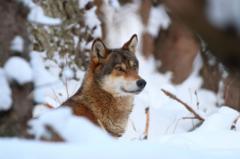A significant shift in the status of grey wolves in Europe may be imminent as the European Commission is set to review the long-standing protections that have been in place for nearly half a century. The proposal aims to change the classification of wolves from Annex II, which allows for strict protections, to Annex III of the Bern Convention. This reclassification could significantly weaken the legal safeguards that have contributed to the population increase of wolves in the EU, which has surged from approximately 11,000 in 2012 to over 20,000 today.
In Romania, shepherd József Rácz tends to his flock of 500 ewes in the snowy village of Sansimion, where he faces the dual challenges of herding and safeguarding against predators such as wolves and bears. Each year, he loses several sheep, and to mitigate this, he relies on his 17 dogs, which he believes are crucial to protecting his livestock. However, Rácz advocates for more robust legal measures allowing for culls, arguing that wolves are cunning hunters capable of causing significant damage to his herd.
Critics of the proposed changes assert that the solution lies not in culling but in implementing better protective measures, such as the use of trained livestock guardian dogs. Wildlife advocates emphasize that wolves play a vital ecological role by controlling populations of deer and wild boar, which can devastate crops and woodlands. Studies show that wolf predation accounts for only a minuscule percentage of livestock losses in the EU, with fatalities from wolf attacks on humans being nonexistent for four decades.
Biologists participating in a recent wildlife summit near Rácz's village highlighted that wolves also play an essential role in controlling diseases within the animal population. They noted that shooting older wolves could destabilize packs, fostering greater conflicts with livestock.
As tensions rise regarding the balance of preserving biodiversity and protecting agricultural interests, EU officials must navigate the intricacies of ecological health and human concerns. Currently, the fate of European wolves hangs in the balance as proposals for culling await a resolution, sparking fierce debate amid stakeholders, policymakers, and the public alike. Local sentiments, like those of Rácz, reveal the ongoing struggle between conservation and the protection of livestock in rural communities confronting increasing wildlife activity.



















